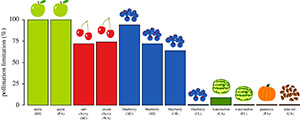
Most readers of this column probably know how important bees are for pollinating crops and contributing to global food production. For example, I’m sure everyone has heard that one out of three bites of food we eat is dependent on pollinating insects.
But how often aren’t there enough bees to pollinate those delicious fruits and vegetables we like to eat? And if we look at the types of bees, is it mostly honey bees (Apis mellifera) or wild non-Apis bees that are doing the work? Also, what’s all this crop pollination worth? In other words, if pollinators didn’t exist to pollinate crops in the U.S., how much money would farmers lose? These are the topics for our thirty-fourth Notes from the Lab, where we summarize “Crop production in the USA is frequently limited by a lack of pollinators,” written by James Reilly and colleagues and published in Proceedings of the Royal Society of London B [287:20200922].
For their study, Reilly and colleagues collected an impressive amount of data. Specifically, the authors surveyed pollinators and assessed crop production in seven pollinator-dependent crops: apple, highbush blueberry, sweet cherry, tart cherry, almond, watermelon and pumpkin. In total, they collected data at 131 commercially managed fields in Michigan, Pennsylvania, Washington, Oregon, Florida, British Columbia and California. All fields were stocked with honey bee hives at rates typical for each region, with the exception of apple and pumpkin fields in Pennsylvania. At those apple and pumpkin fields, farmers did not use honey bees because wild bees were thought to provide sufficient pollination.
At each field, the authors assessed pollinator visitation rates via multiple 100 m transect surveys. Observers walked along the transects and recorded the number and types of bees visiting flowers. Bees were identified on-the-wing and lumped into groups such as “bumble bees,” “carpenter bees,” or “green bees.” All honey bees (Apis mellifera) were identified to species because it is easy to make this species-level identification in the field.
Next, Reilly and colleagues assessed efficiency of fruit/vegetable production by comparing flower counts to fruit/vegetable counts post-bloom and during harvest. In other words, production was considered highly efficient if a large proportion of flowers turned into fruits/vegetables, but production was considered inefficient (and therefore potentially limited by pollination) if a small proportion of flowers turned into fruits/vegetables. For pumpkin and watermelon, production was measured by area and thus corresponded directly to yield, while for other crops the measurement was an approximation of area and therefore referred to more generally as production.
To assess how often pollinator limitation occurred for each crop, the authors related pollinator visitation rates to production efficiency. If there was no relationship, this was taken as evidence for no pollinator limitation (i.e., plenty of pollinators were always present). If there was a positive relationship, this was taken as evidence for pollinator limitation (i.e., by adding more pollinators, production increased). When pollinator limitation occurred, the proportion of transects experiencing limitation was determined via the breakpoint where an increase in pollinators did not increase production.
Finally, to assess the relative importance of honey bees and wild bees as crop pollinators, the authors tapped into extensive literature on the efficiency of pollen transfer for each type of bee, multiplying this efficiency by the abundance of the honey bees and wild non-Apis bees that were observed visiting flowers for each crop.
So, what did they find? Are crops in the U.S. limited by pollinators? Yes. For four of the seven crops (apple, tart cherry, sweet cherry and blueberry), insufficient numbers of pollinators frequently limit production. In the apple orchards sampled (Figure 1, light green bars), pollinator limitation occurs all the time; 100% of the samples show that having more pollinators will lead to more fruits. Importantly, this study includes the impact of thinning (i.e., most apple growers remove flowers after pollination so only a fraction of the successfully pollinated flowers will develop into larger fruits). Even when accounting for thinning, greater apple production always occurred with more pollinators.
For cherries and blueberries in the northern U.S., production was found to be limited by insufficient pollinators 64-94% of the time (Figure 1, red and blue bars). However, for three of the seven crops (watermelon, pumpkin and almond), pollinators were rarely if ever found to be limiting. In addition, blueberry in Florida was not found to be ….


